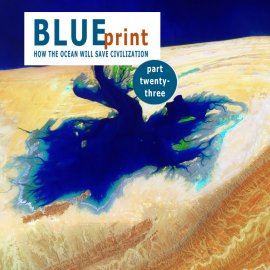Units of Calculation
-
English
-
ListenPause
[intro music]
Welcome to World Ocean Observatory…
I’m Peter Neill, Director of the World Ocean Observatory.
We learn the basic structure of Nature as an arrangement of cells, gossamer walls, cleverly symmetrical, and connected unit to unit as building blocks from micro to macro-scopic, mostly invisible but sometimes glimpsed as if an architectural detail in the construction of a cathedral.
I think of bee hives, the honeycomb a form of perfect hexagons filled like storage units by swarms of female worker bees, hoarding honey to support the queen or the marauding bears, each cell its own deposit box of color, richness and sustenance.Today, that beauty is seen by some in numbers, the X cells in automated balance sheets, that have another, very different dynamic of measured value, interacting with other cells, other numbers, all around, in a circulation of value, an architecture of data, of estimates, of shifting premises, of budgets that fix and fease into a mathematical truth that has, for some, yes, the beauty of a cathedral. There also marauding bears, and bulls.
I am belaboring the metaphor, but it is one aspect of our social condition that we measure value and calculate it as part of a financial equation, a balance sheet comprising the totality of many cells of numbers. But like Excel and similar software tools, the final number, positive or negative, is as ephemeral as the assumptions made to fill every cell in our budget or projection or prospectus, right or wrong, truth will tell.
For some, Nature’s cells aggregate less according to a designer’s will, more according to an evolutionary process of life and death, pollination and fertilization, or adaptation to crises that bring down those tiny cathedrals, only to build them up again with different, often better, design and utility. Look at cells in a leaf of a plant in a marsh in an ecology in a region with a purpose, for example, to protect margins and edges from other forces, waves and wind, inundation and aggregation, that in turn affect the cells of our lives, our social units, our hopes and fears. A simple building block to accrue into a complicated system. A salt marsh. A mangrove swamp. A coastal community. A life, a death, cells aggrandized to the human body, a family, a nation state, at any moment its value threatened, its viability questioned.
To delimit cells in a grid of limited inclusion of all elements within the system is a false calculation. For example, to build a budget for a business that relies on water as an essential element must include not only the cost of that water, but also the cost of any remediation or replacement of that natural value compromised by the process. To build a factory that emits CO2 or waste must also include in its due diligence the negative value of injury to public health in the air or of toxicity downstream to natural areas, shellfish beds, or recreation. To search and extract oil and gas, or to fish indiscriminately, in a coastwise barrier reef must also include the cost of destroyed fisheries habitat, tourism revenues, and medicinal discoveries lost to future science and cures for disease unknown. Spreadsheets are like jurisdictions, limited in scope and scale, and can be made to justify a positive investment when the true cost of these externals are left out of the analyses, justifications, permitting, and calculated return.
Such exclusions present a false narrative with after-the-fact revealed social and political consequences that add yet again to the true accounting cost of the development proposed. What has been missing from the financial cartography is natural value of any natural area or process that is affected by any action within. Ecosystems services can easily be estimated and added as another column of cells within any financial analysis that, by that final keystroke, reveals a summation of what is truly contained within those gossamer walls, unit by unit assembled into enterprise and the global economy, sustainable and rewarding at every level of society on land or sea. If Nature is comprised of units of calculation, then we are the mathematicians, and we had best get our numbers clear and comprehensive, the answer right, not wrong, if we are to sustain the color, richness, and sustenance of our natural world; if we are to assure survival of life and civilization; if we are to preserve the cathedral where we assemble, worship, and endure.
We will discuss these issues, and more, in future editions of World Ocean Radio.
[outro music]
This week on World Ocean Radio: part twenty-three of the multi-part BLUEprint series. In this episode: the importance of including true accounting costs for natural resources extracted or exploited; for the downstream effects of industry and enterprise; for loss of revenue by destroyed habitats; and much more. We argue that ecosystem services can be easily estimated and added as we begin to calculate the true costs of all externals for inclusion in future analyses and development.

The "BLUEprint Series: How the Ocean Will Save Civilization" outlines a new and sustainable path forward, with the ocean leading the way.
About World Ocean Radio
Since 2009, a weekly 5-minute podcast covering a broad spectrum of ocean issues from science and education to advocacy and exemplary projects. World Ocean Radio, a project of the World Ocean Observatory, is available for syndicated use at no cost by college and community radio stations worldwide. Contact director@thew2o.net if you are interested in becoming an affiliate or know of a radio station that should be broadcasting these episodes each week.
Image
Khor Kalmat, Pakistan. The Khor Kalmat lagoon branches off the Arabian Sea and spills into the southern Pakistan landscape near the Makran Coast Range. Mudflats cover most of the lagoon, which fills with shallow water at high tides. The small areas of green are isolated pockets of mangrove forest. Credit @USGS
- Login to post comments



